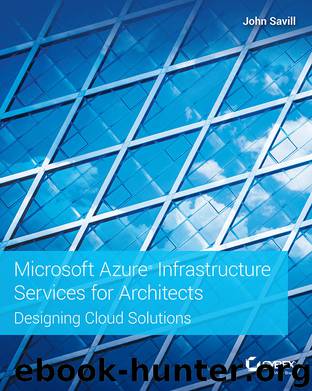Microsoft Azure Infrastructure Services for Architects by John Savill

Author:John Savill
Language: eng
Format: epub
ISBN: 9781119596547
Publisher: Wiley
Published: 2019-09-25T14:00:00+00:00
DNS is used for the Azure Storage namespace, which is why when talking about Azure Storage accounts and services, you will see the following format:
http(s)://<account>.<service>.core.windows.net/<partition>/object
Using Storage Accounts and Types of Replication
I’ve already referred to storage accounts, so it’s important to understand what a storage account is, how Azure limits storage accounts, and how to choose your storage account design. All data stored in Azure Storage is stored in a storage account. It should be noted that when dealing with VMs, you typically don’t deal with storage accounts. You used to, as the VHD files for VMs were stored in page blobs, which were stored in storage accounts, which required tracking of the number of VHDs per storage account to ensure limits of the storage account did not impact performance and also had challenges when you wanted to change the performance tier. All this was solved with managed disks (covered later), which abstracted away the storage account (it’s still there but basically hidden from you) and made disks a first-class Azure resource. It is still useful to understand storage accounts because even when you are dealing with infrastructure, the capabilities of storage accounts may be useful.
A storage account has a number of attributes:
Each account must have a name that is unique across all of Azure Storage namespace. Azure Storage can be accessed using URLs, and the name you specify is a component of the URL.
Each account must belong to a subscription.
Each account must be created in a particular region. For best performance, you try to keep the location of the storage account in the same region as the service using it.
Each account must specify the replication to be used for the content.
Each account has a performance type—for example, standard (HDD-based) or premium (SSD-based).
A default access tier is specified, hot or cool (this impacts costs related to storage and transactions), but can also be set per object for most account types.
Storage accounts have a type, such as general-purpose v1, v2, blob storage, or file storage.
Each account has a maximum number of IOPS. The Azure storage limits page should be checked for exact, current values, as they do change.
Each account also has size, ingress, and egress limits.
Each account has a set of URL endpoints that are used to access the storage. The URL includes the name specified during creation. A different URL is used for each of the four types of storage services available: Blobs, tables, queues, and files. The URLs use the following format:
https://<storage account name>.<storage service>.core.windows.net
For example, https://savillstorage.blob.core.windows.net/ would be my BLOB endpoint. You can add custom URLs to access storage accounts. Custom URLs are documented at: https://docs.microsoft.com/en-us/azure/storage/blobs/storage-custom-domain-name
Download
This site does not store any files on its server. We only index and link to content provided by other sites. Please contact the content providers to delete copyright contents if any and email us, we'll remove relevant links or contents immediately.
Sass and Compass in Action by Wynn Netherland Nathan Weizenbaum Chris Eppstein Brandon Mathis(7969)
Grails in Action by Glen Smith Peter Ledbrook(7942)
Configuring Windows Server Hybrid Advanced Services Exam Ref AZ-801 by Chris Gill(7347)
Azure Containers Explained by Wesley Haakman & Richard Hooper(7335)
Running Windows Containers on AWS by Marcio Morales(6880)
Kotlin in Action by Dmitry Jemerov(5369)
Microsoft 365 Identity and Services Exam Guide MS-100 by Aaron Guilmette(5343)
Microsoft Cybersecurity Architect Exam Ref SC-100 by Dwayne Natwick(5113)
Combating Crime on the Dark Web by Nearchos Nearchou(4917)
The Ruby Workshop by Akshat Paul Peter Philips Dániel Szabó and Cheyne Wallace(4612)
Management Strategies for the Cloud Revolution: How Cloud Computing Is Transforming Business and Why You Can't Afford to Be Left Behind by Charles Babcock(4510)
The Age of Surveillance Capitalism by Shoshana Zuboff(4192)
Python for Security and Networking - Third Edition by José Manuel Ortega(4184)
Learn Wireshark by Lisa Bock(4030)
The Ultimate Docker Container Book by Schenker Gabriel N.;(3838)
Learn Windows PowerShell in a Month of Lunches by Don Jones(3587)
DevSecOps in Practice with VMware Tanzu by Parth Pandit & Robert Hardt(3508)
Windows Ransomware Detection and Protection by Marius Sandbu(3500)
Blockchain Basics by Daniel Drescher(3475)
